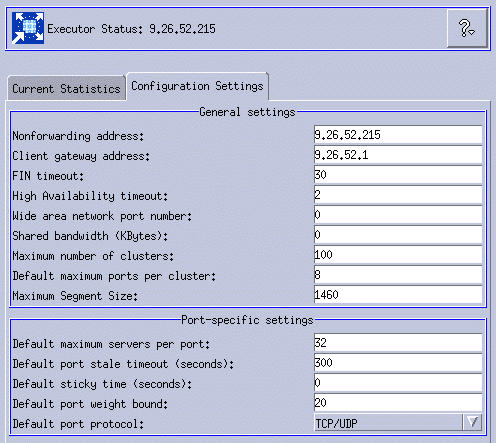Load Balancer Executor
To display executor settings, select Executor: IP address in the tree view, then click Configuration settings in the right pane. This displays the executor settings, as shown in Figure 19-5.

Figure 19-5 Executor settings
The following parameters have an impact on performance:
- High Availability time out: The number of seconds that the executor uses to time out High Availability heartbeats. The default value is 2. Decrease this if you want to force faster takeover when the Load Balancer is in standby mode. To avoid too many takeovers, do not choose a value that is too small.
- FIN timeout: A client sends a FIN packet after it has sent all its packets so that the server will know that the transaction is finished. When Dispatcher receives the FIN packet, it marks the transaction from active state to FIN state. When a transaction is marked FIN, the memory reserved for the connection can be cleared.
To improve the performance of connection record allocation and reuse, set FIN time out to control the period during which Dispatcher should keep connections in the FIN state active in the Dispatcher tables and accepting traffic. Once a connection in the FIN state exceeds the FIN time out, it will be removed from the Dispatcher tables and ready for reuse.
Once a connection in the FIN state exceeds fintimeout, it will be removed from the Dispatcher tables and ready for reuse.
- Maximum segment size: Dispatcher does not support MTU negotiation for Dispatcher's NAT (or CBR, see 19.3.3, Configure CBR and SSL session ID affinity) forwarding method because it is actively involved as an endpoint for TCP connections. For NAT and CBR forwarding, Dispatcher defaults the MTU value to 1500. This value is the typical MTU size for standard Ethernet, so you will probably not need to adjust this setting.
When using Dispatcher's NAT or CBR forwarding method, if you have a router to the local segment that has a lower MTU, set the MTU on the Dispatcher machine to match the lower MTU.
| xxxx |